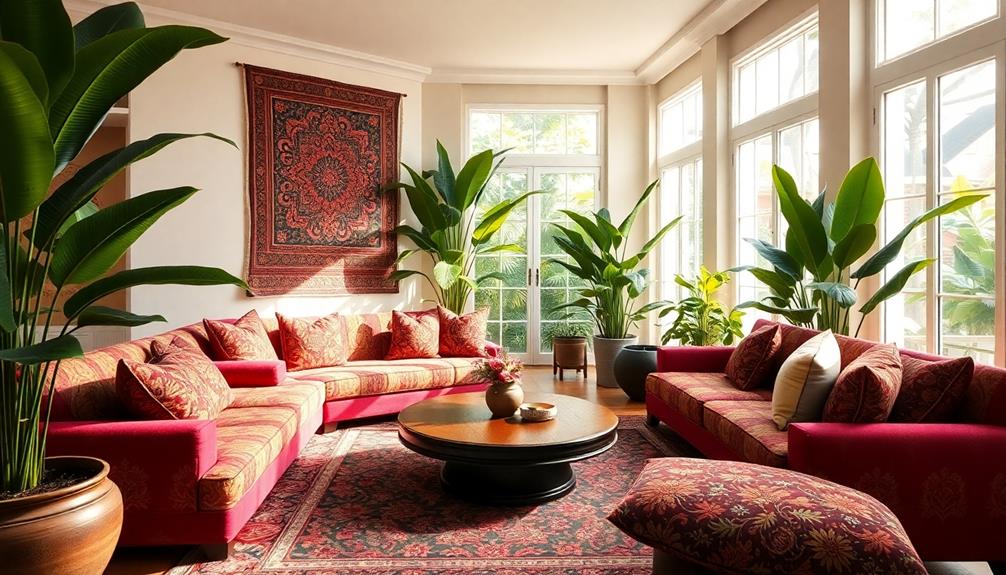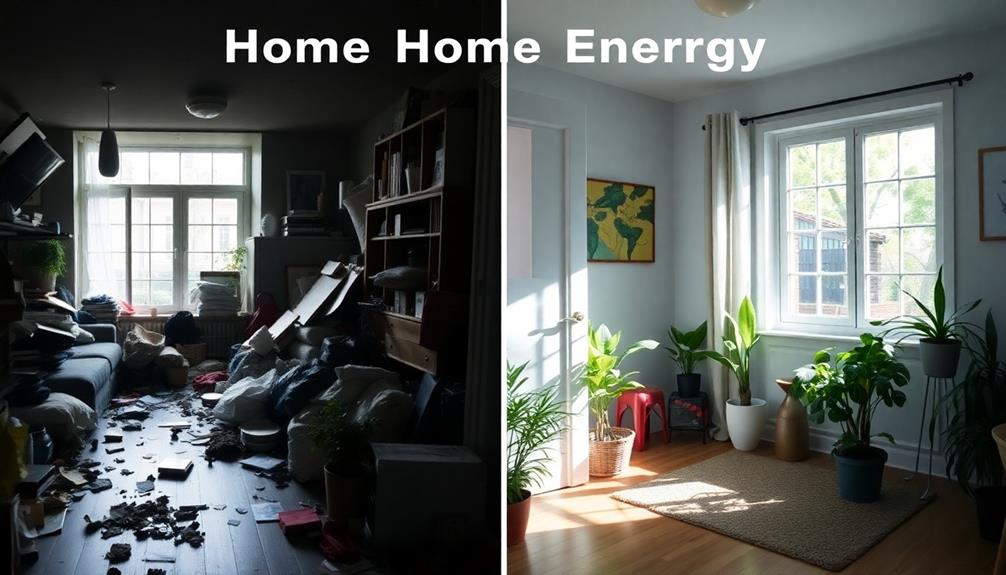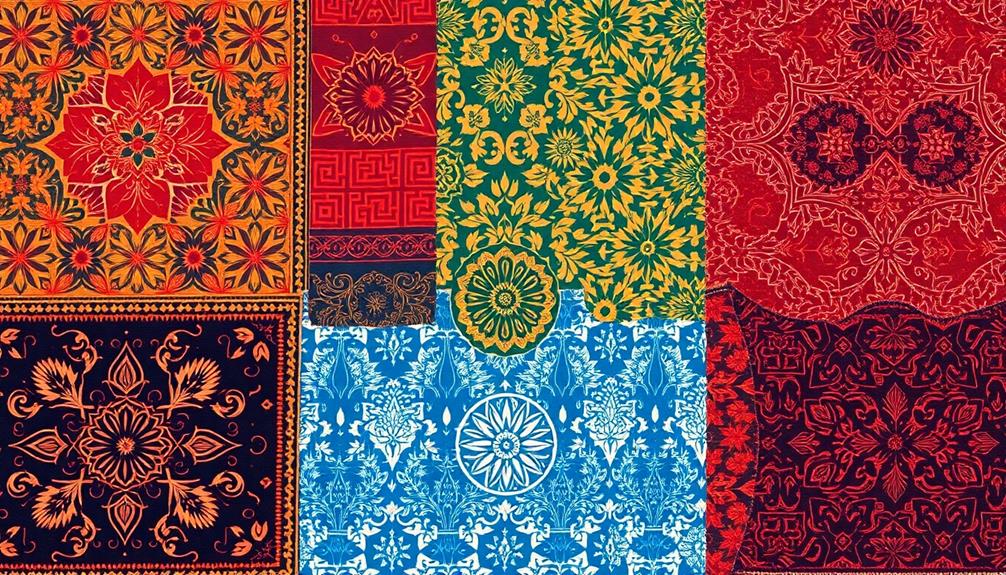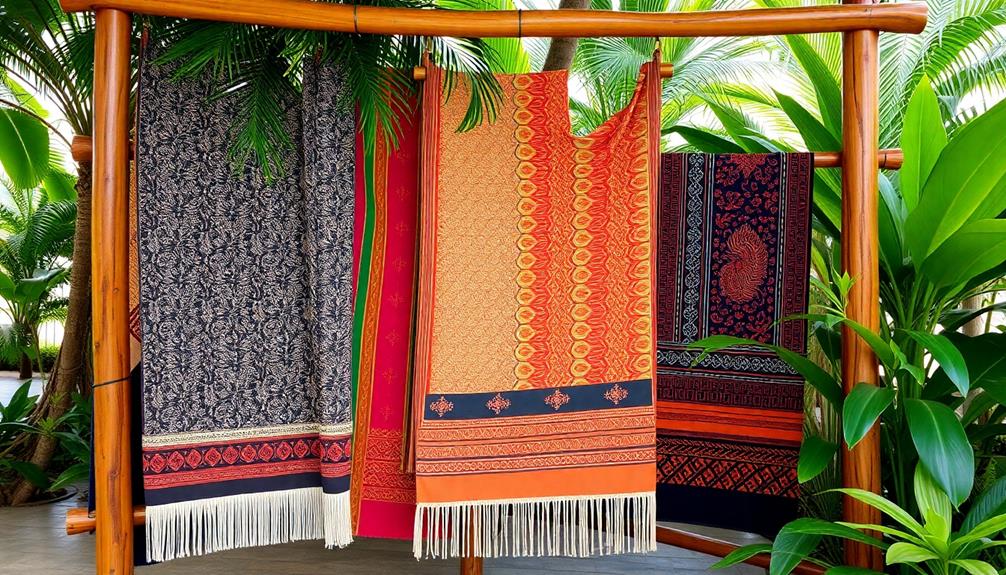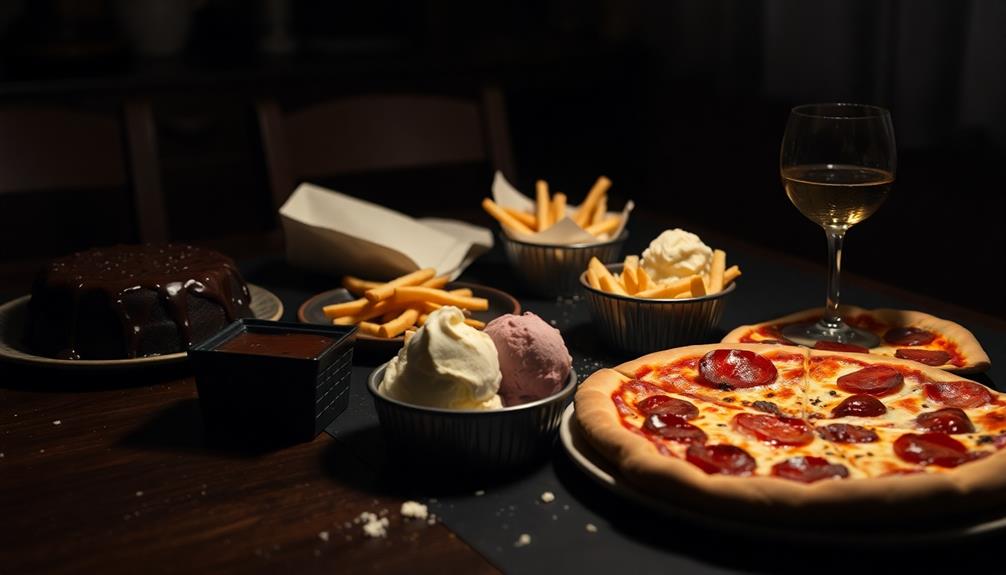Indonesian textiles are a vibrant addition to your modern space, offering color and cultural richness. With techniques like Batik and Ikat, these textiles feature intricate patterns that tell stories and reflect their heritage. Their sustainable craftsmanship, using natural dyes from local plants, guarantees a deep connection to the environment and community. You'll find variations across regions, each showcasing unique patterns and significance. Incorporating these textiles not only elevates your decor but also preserves cultural identity and history. If you're curious about how to integrate these stunning pieces into your home, there's much more to explore.
Key Takeaways
- Indonesian textiles like Batik and Ikat blend rich cultural heritage with modern aesthetics, enhancing contemporary interior design.
- The use of natural dyes from local plants promotes sustainability and supports local economies while preserving traditional craftsmanship.
- Unique regional styles, such as Java's vibrant Batik and Sumba's Ikat, showcase intricate patterns that tell stories and reflect cultural identity.
- Collaborations between artisans and designers lead to innovative products that merge traditional techniques with modern applications in fashion and home decor.
- Online marketplaces and museum exhibitions provide access to authentic Indonesian textiles, increasing their visibility and appreciation in global design contexts.
Overview of Indonesian Textiles
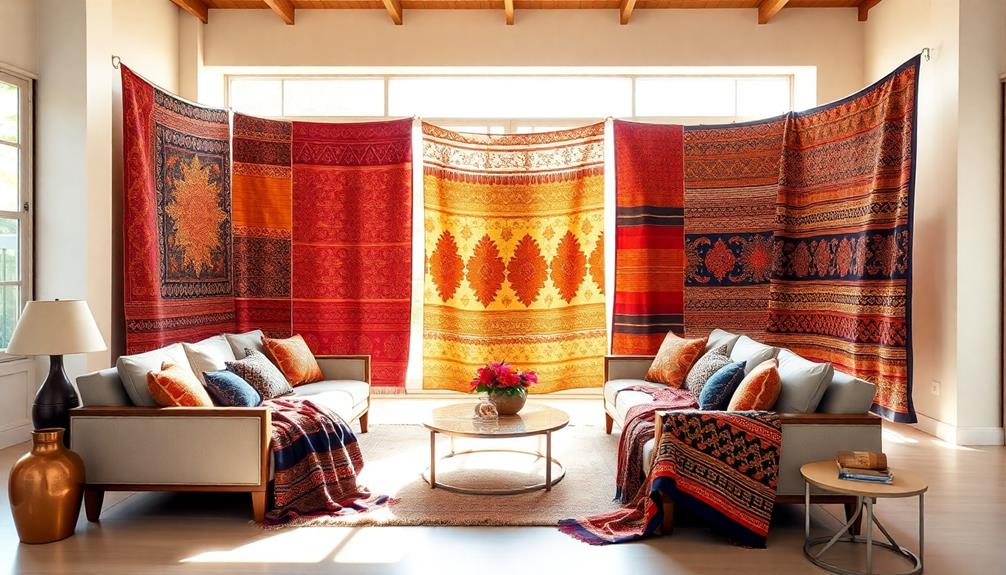
Indonesian textiles are a vibrant tapestry woven from the rich cultural heritage of the archipelago. These textiles, including Batik and Ikat, showcase the country's diversity and artistry. Batik, renowned for its intricate wax-resist dyeing, tells stories through detailed patterns, while Ikat employs a resist-dye technique before weaving, creating stunning visuals that reflect cultural identity.
Moreover, much like the Indonesian decor masks that highlight traditional craftsmanship, these textiles are crafted with great care and skill.
You'll discover textiles crafted with traditional weaving techniques that highlight the skill and dedication of artisans. These craftsmen utilize natural dyes from local plants, ensuring each piece resonates with deep cultural meanings. Each design often carries historical significance, linked to social status and rituals celebrated in Indonesian communities.
The Thomas Murray collection emphasizes the importance of ritual clothing and ceremonial cloths, featuring textiles from regions like Batak and Lampung in Sumatra, Dayak textiles from Borneo, and Toraja from Sulawesi.
Each region's textiles embody unique craftsmanship and regional traditions, making them not just fabrics but essential expressions of Indonesia's rich cultural narrative. By embracing these textiles, you connect with the stories and values of Indonesian heritage, enriching both your space and your understanding of this beautiful culture.
Regional Variations and Styles
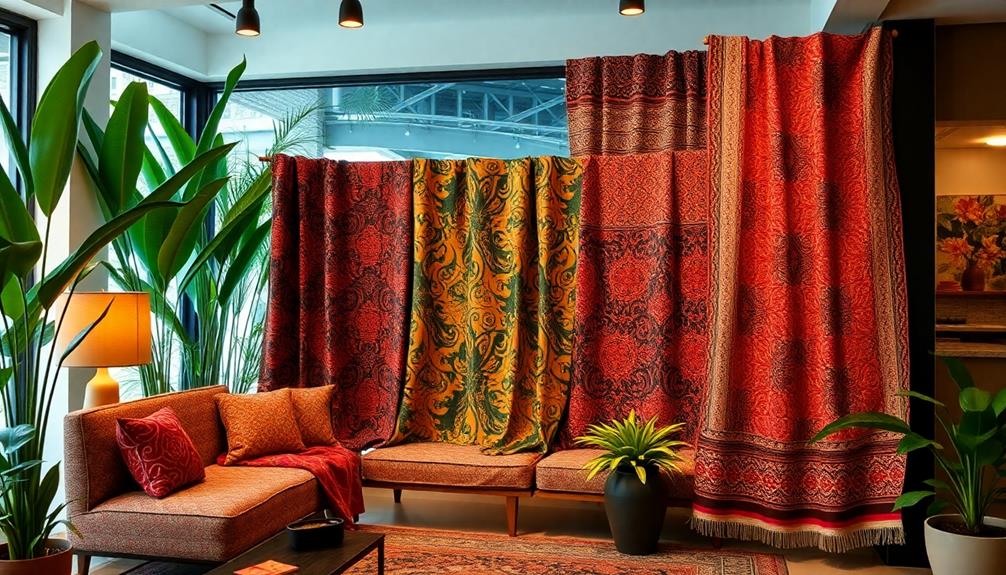
Across the archipelago, regional variations in textile styles highlight the incredible diversity of Indonesia's cultural fabric.
When you explore Indonesian textiles, you'll encounter Batik from Java, renowned for its intricate wax-resist dyeing techniques, which often feature vibrant colors and intricate patterns that enhance living spaces. In contrast, Ikat from Sumba showcases tie-dye patterns created before weaving, offering a unique aesthetic.
In Lampung, the Tapis stands out with its long strips of handwoven cloth, adorned with gold-wrapped threads that symbolize social status and cultural pride.
Venture to Borneo, and you'll find Dayak textiles, characterized by bold geometric patterns that reflect a deep connection to nature and spirituality.
Toraja textiles from Sulawesi are equally enchanting, featuring elaborate ceremonial cloths rich in symbolism and craftsmanship, integral to local rituals.
Don't overlook the rare textiles from regions like Timor and Sumba, which reveal diverse materials and techniques, each a proof of the unique cultural heritage and artistry of its origin.
Embrace these regional variations, and you'll appreciate how each piece not only tells a story but also transforms modern spaces with their vibrant history and beauty.
Craftsmanship and Techniques
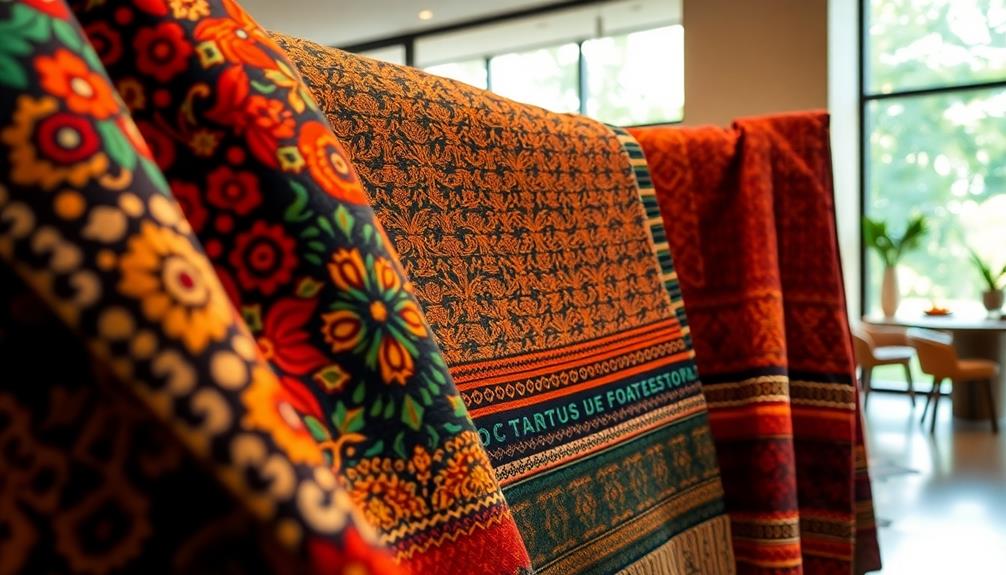
When you explore Indonesian textiles, you'll notice the diverse weaving techniques that define each region's unique style.
These textiles often reflect a rich cultural heritage, much like the vibrant artistry found in Indonesian decor masks.
Artisans use natural dyes from local plants, which not only enhance the colors but also promote sustainability.
These practices highlight the intricate craftsmanship that has been passed down through generations, making each piece truly special.
Weaving Techniques Explained
Immerse yourself in the vibrant world of weaving techniques that bring Indonesian textiles to life. You'll discover the beauty of Batik, a method that uses intricate wax-resist dyeing to create stunning patterns. This traditional craft reflects the cultural significance of housing, as many textiles are used in ceremonial functions tied to specific architectural features.
Then there's Ikat, where artisans bundle threads to prevent dyeing specific sections before weaving, resulting in unique designs with a characteristic blurred effect.
Songket and Tenun also showcase exceptional craftsmanship, with Songket incorporating gold or silver threads, adding a luxurious touch. Each technique highlights the rich cultural significance and regional styles that define Indonesian textiles, often paralleling the distinct architectural styles found in traditional Indonesian housing.
Artisans spend years mastering these techniques, with skills often passed down through generations. This dedication reflects the importance of textiles in rituals and ceremonies, embodying social status and cultural identity.
Furthermore, many traditional practices utilize natural dyes derived from local plants, emphasizing sustainability and the artisans' connection to their environment.
In regions like Lampung and Borneo, the intricate craftsmanship in these textiles preserves storytelling elements, ensuring that cultural narratives remain alive through their stunning designs.
Natural Dye Sources
The vibrant colors of Indonesian textiles owe much to the natural dyes sourced from local plants, showcasing the region's rich biodiversity. Artisans skillfully extract these natural dyes from indigofera for blue, turmeric for yellow, and various roots and barks for reds and browns. This not only enhances the aesthetic quality of textiles but also embodies sustainable practices, as these materials are biodegradable and often sourced locally.
Additionally, the use of traditional techniques reflects the long-standing cultural significance of these crafts, similar to the way Indonesian decor masks represent rich heritage and traditions.
Using traditional dyeing techniques, artisans engage in meticulous processes, such as fermenting indigo, which can take days to achieve the perfect hue. The choice of natural dyes goes beyond aesthetics; it's steeped in cultural symbolism. Each color carries specific meanings, often linked to ceremonies or social statuses within Indonesian communities.
The craftsmanship involved in creating these textiles is a reflection of ancestral knowledge, passed down through generations. By choosing naturally dyed fabrics, you're not just embracing beautiful designs; you're also supporting the preservation of Indonesia's rich cultural heritage.
Cultural Importance of Textiles
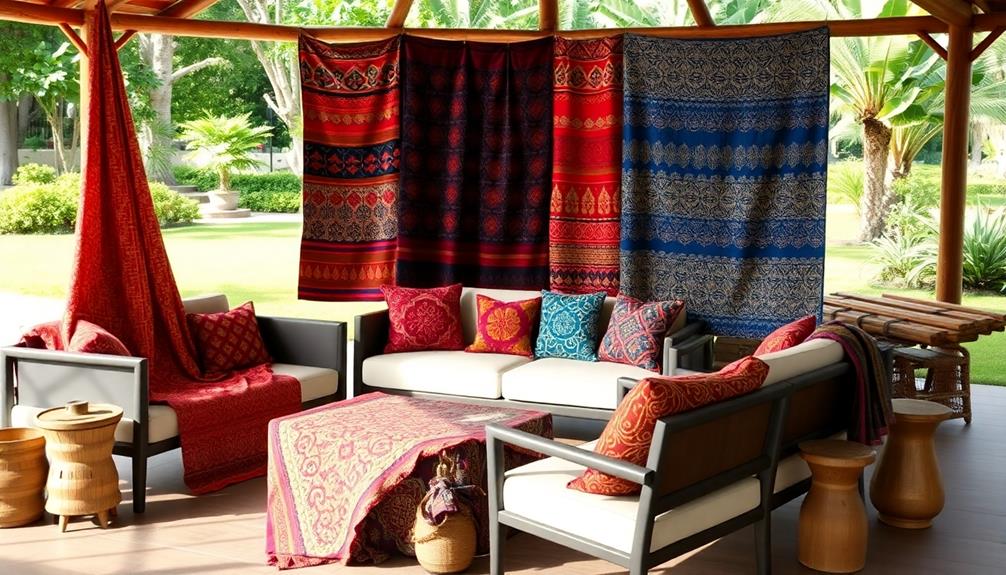
Indonesian textiles, particularly Batik, Ikat, and Tapis, hold immense cultural significance, serving as essential elements in various ceremonies and rituals. These textiles often symbolize social status and identity, reflecting the values and traditions within communities.
For instance, Tapis textiles from Lampung province are intricately crafted with gold-wrapped threads and vibrant colors, representing familial wealth and lineage. The use of natural materials and sustainable practices in crafting these textiles mirrors the principles of Balinese design characteristics, emphasizing a connection to nature and traditional craftsmanship.
The patterns and colors you see in Indonesian textiles carry deep symbolic meanings, rooted in pre-Islamic traditions and storytelling. Each motif, such as the Naga, embodies narratives of fertility and community pride, preserving cultural heritage through their intricate designs.
When you wear or display these textiles, you're not just showcasing beautiful craftsmanship; you're also connecting with a rich history. Moreover, the artisans behind these creations employ sustainable practices and natural dyes, emphasizing their commitment to the environment.
This connection between traditional artistry and contemporary life makes Indonesian textiles even more relevant today. By embracing these textiles, you celebrate not only their aesthetic appeal but also the enduring stories and values they represent, ensuring that the cultural importance of these fabrics continues to thrive.
Historical Context and Influences

When you explore Indonesian textiles, you'll notice how trade routes notably shaped their evolution.
The rich tapestry of Indonesian culture is mirrored in its architectural practices, such as the modern tropical aesthetics in Bali, which emphasize natural materials and sustainability.
Colonial influences and cultural exchanges introduced new techniques and designs, enriching the fabric of Indonesian artistry.
Understanding these historical contexts helps you appreciate the unique stories woven into each piece.
Trade Route Impact
Throughout history, trade routes have played an essential role in shaping the textile landscape of Indonesia, enabling a vibrant exchange of ideas, techniques, and materials. As you explore Indonesian textiles, you'll notice how these historical trade routes introduced diverse influences from cultures like China, India, and the Arab world. This interaction enriched the complexity and visual appeal of textiles, making them cultural symbols of Indonesia's shared heritage.
| Textile Type | Influences | Regional Adaptations |
|---|---|---|
| Batik | Indian, Chinese | Java, Bali, Sumatra |
| Ikat | Malay, Indian | Sumba, Flores |
| Songket | Malay, Arabic | Bali, Lombok |
| Tenun | Chinese | Nusa Tenggara |
| Perca | Local traditions | Various regions |
Each textile type reflects unique regional adaptations that emerged from these exchanges. The complexity of Batik, the intricate patterns of Ikat, and the luxurious feel of Songket all showcase Indonesia's rich diversity. Collectively, they tell the story of a nation shaped by centuries of trade, interaction, and creativity, deeply embedded in its cultural identity.
Colonial Influences
The colonial period markedly reshaped the textile landscape in Indonesia, blending European techniques with local craftsmanship. This period also witnessed a transformation in housing designs, where the influence of colonial architecture can still be observed today, reflecting a hybridization of styles that includes diverse architectural styles.
You can see how this fusion created hybrid forms that beautifully meld traditional motifs with Western styles. The popularity of Batik, for instance, adapted to colonial tastes while still preserving its indigenous roots.
Colonial powers exploited local artisans, often commercializing textiles for export markets, which altered traditional practices and diminished the cultural significance of these fabrics. Trade routes established during this era allowed Indonesian weavers to access new dyes and patterns, further enriching their craft.
Today, remnants of this colonial influence are apparent in contemporary textile designs, showcasing a rich tapestry of textile heritage. As you explore these modern interpretations, you'll notice how they honor the past while embracing innovation.
The legacy of the colonial period isn't just a historical footnote; it's a crucial part of Indonesia's textile narrative, informing both the artistry and the commercial aspects of textiles today. Understanding this context helps you appreciate the depth and complexity behind each piece, making Indonesian textiles not just decorative items, but carriers of history and culture.
Cultural Exchange Dynamics
Cultural exchange played a pivotal role in shaping Indonesian textiles, influenced by centuries of trade with regions like China, India, and the Arab world. This rich interaction has woven various cultural threads into the fabric of Indonesian heritage, much like the intricate carvings found in traditional Indonesian style home decor.
Here's how these dynamics unfolded:
- Traditional Weaving Techniques: The preservation of traditional methods has allowed artisans to maintain their cultural identity.
- Colonial Influences: European colonization introduced new textile techniques and aesthetics, blending them with existing practices.
- Pre-Islamic Traditions: Many intricate designs reflect ancient beliefs, showcasing a continuity of craftsmanship through time.
- Rituals and Ceremonies: Textiles often signify status and identity, playing essential roles in various cultural narratives.
As you explore modern designs, you'll notice that they often pay homage to these historical influences while embracing contemporary aesthetics.
The craftsmanship behind Indonesian textiles isn't just about beauty; it's a reflection of a rich heritage that honors the past. By understanding these cultural exchange dynamics, you can appreciate how Indonesian textiles continue to transform modern spaces, bridging tradition and innovation seamlessly.
Modern Applications in Design
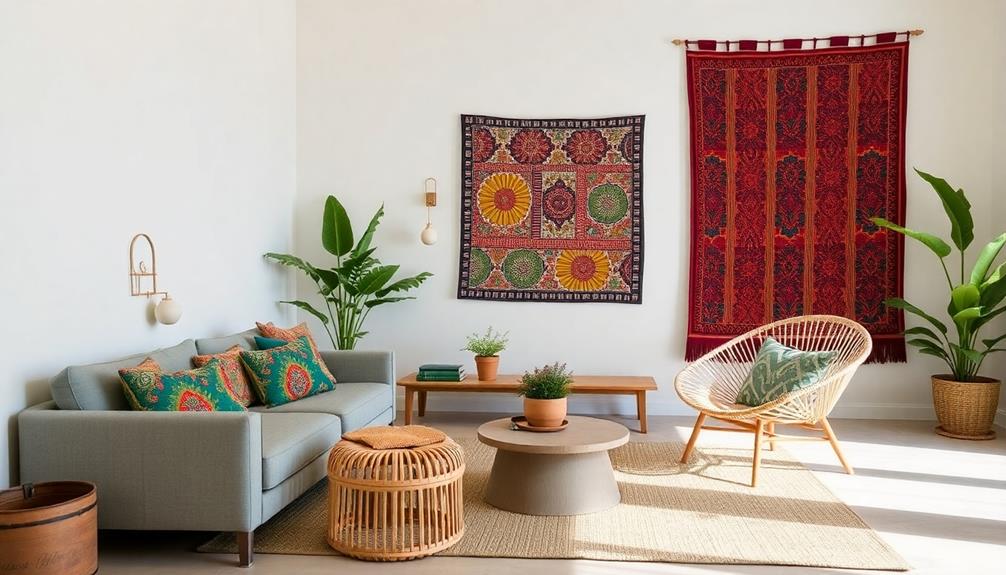
In recent years, Indonesian textiles have found a vibrant place in modern design, transforming everyday spaces with their rich colors and intricate patterns. You can easily enhance your home decor by incorporating these stunning pieces, like throw pillows, table runners, and wall hangings. The blend of contemporary design with traditional craftsmanship creates an eye-catching aesthetic that resonates with many.
Additionally, the influence of luxury tropical design aesthetics elevates the integration of these textiles, bringing a unique flair to interiors.
As a consumer, you might appreciate the growing focus on sustainable textiles. Designers are increasingly utilizing traditional weaving techniques to produce unique, eco-friendly materials that showcase cultural heritage. Collaborations between artisans and contemporary designers are resulting in innovative products that marry age-old methods with modern sensibilities.
Thanks to online marketplaces, accessing authentic pieces is easier than ever. You can explore a wide range of Indonesian textiles, enriching your interior design with a touch of cultural significance.
Furthermore, these textiles are making waves in the fashion world, with high-end designers integrating traditional patterns into contemporary collections. This surge in popularity highlights the versatility and relevance of Indonesian textiles, ensuring they remain an essential part of today's aesthetic landscape.
Embrace these beautiful elements and let them elevate your space!
Iconic Textile Types: Batik and Ikat
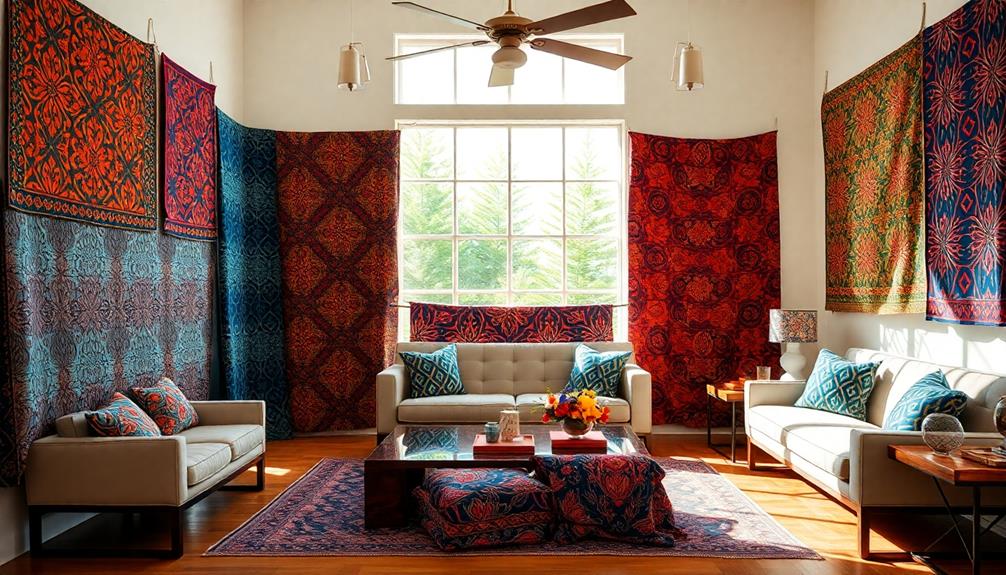
Countless artisans across Indonesia create stunning textiles that highlight the country's rich heritage, with Batik and Ikat leading the way.
These traditional textiles aren't just beautiful; they embody intricate patterns and deep cultural significance. Here's why they're so iconic:
- Batik: Known for its unique wax-resist dyeing technique, Batik features detailed patterns that often convey stories or symbolism. It's primarily associated with Java.
- Ikat: This textile showcases a resist-dye method where threads are dyed before weaving. The result is mesmerizing designs that may appear slightly blurred, prevalent in regions like Sumba and Borneo.
- Cultural Heritage: Both Batik and Ikat reflect Indonesia's diverse cultural identity, showcasing regional variations and styles.
- Sustainable Practices: Skilled artisans use natural dyes sourced from local plants, ensuring that their techniques support environmentally friendly practices.
Both Batik and Ikat also hold significant roles in traditional ceremonies, symbolizing cultural identity and social status within communities.
Resources for Further Exploration

Exploring the world of Indonesian textiles can be incredibly rewarding, as numerous resources are available to deepen your understanding of these art forms.
Start by visiting academic libraries, where you'll find extensive literature on ikat textiles. Works by authors like Marie Jeanne Adams offer valuable insights into their cultural significance and production techniques.
Online platforms and specialized websites also provide access to a variety of studies and articles that explore the artistry of Indonesian textiles. These resources make it easier for you to appreciate the intricate designs and historical context behind these textiles.
Don't miss out on museum exhibitions showcasing significant pieces from diverse collections.
These exhibitions not only display stunning textiles but also engage the public in the importance of textile heritage. Collaborating with international institutions like the Rotterdam Museum of Ethnology and the Metropolitan Museum of Art enhances the visibility and accessibility of these cultural treasures.
Frequently Asked Questions
Where Can I Purchase Authentic Indonesian Textiles Online?
You can purchase authentic Indonesian textiles online through various marketplaces like Etsy, or specialized websites like Dewa Ruci and Threads of Life. Just verify you check reviews to guarantee quality and authenticity before buying.
How Do I Care for Indonesian Textiles at Home?
Caring for Indonesian textiles is like nurturing a delicate flower. Gently hand wash in cold water, avoid harsh detergents, and lay flat to dry. Remember, your love and attention will keep their vibrant beauty alive.
Are Indonesian Textiles Sustainable and Eco-Friendly?
Yes, Indonesian textiles often prioritize sustainability. Many artisans use eco-friendly materials and traditional methods, minimizing environmental impact. By choosing these textiles, you support ethical practices and contribute to preserving cultural heritage while enhancing your home's aesthetic.
What Are the Most Popular Colors in Indonesian Textiles?
When you explore Indonesian textiles, vibrant hues like deep reds symbolize passion, lush greens represent nature, and rich blues evoke serenity. These popular colors infuse energy into spaces, transforming them into enchanting reflections of culture and artistry.
Can Indonesian Textiles Be Used in Outdoor Settings?
Yes, you can definitely use Indonesian textiles in outdoor settings. They add vibrant colors and unique patterns, enhancing your space. Just make sure you choose fabrics that are durable and weather-resistant for lasting beauty.
Conclusion
Indonesian textiles blend tradition and modernity, showcasing vibrant patterns that transform contemporary spaces. While batik tells stories of heritage, ikat introduces a playful twist to minimalist designs. This contrast not only enriches your decor but also deepens your appreciation for craftsmanship. As you explore these hidden gems, you'll discover that each piece carries a history, inviting you to connect with cultures far beyond your own. Embrace the beauty of these textiles, and let them inspire your surroundings.
